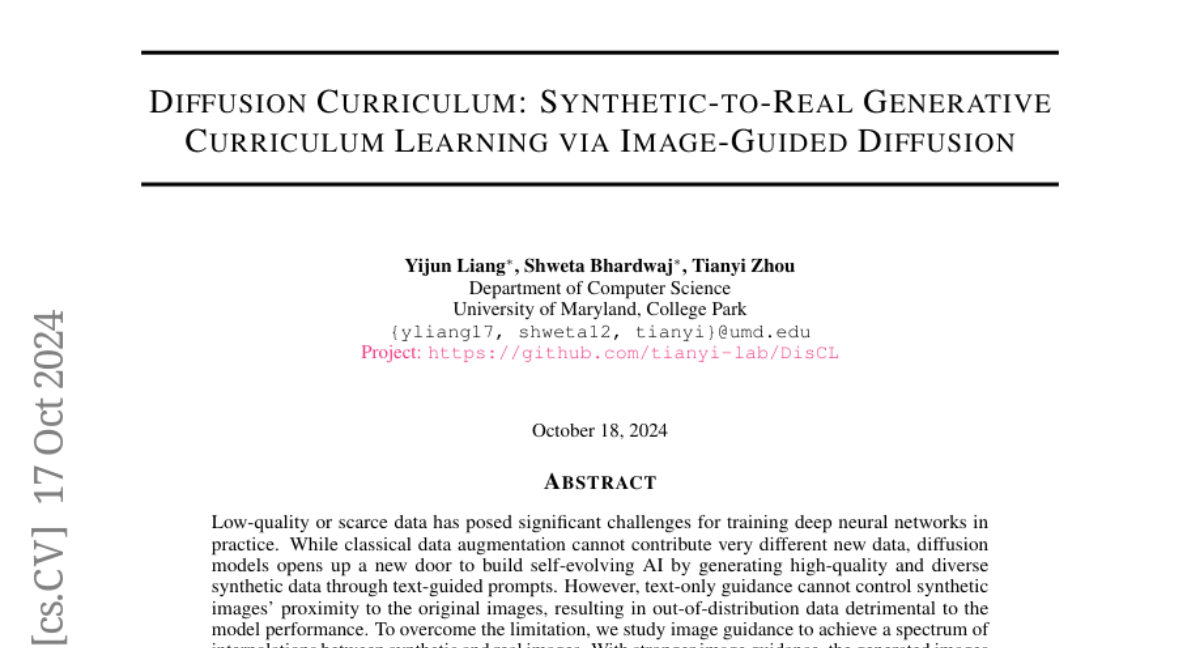Diffusion Curriculum: Synthetic-to-Real Generative Curriculum Learning via Image-Guided Diffusion
Yijun Liang, Shweta Bhardwaj, Tianyi Zhou
2024-10-21

Summary
This paper presents the Diffusion Curriculum (DisCL), a new approach that uses image-guided diffusion to generate high-quality synthetic data, helping to improve the training of deep learning models.
What's the problem?
Training deep learning models often requires a lot of high-quality data, but sometimes there isn't enough good data available. Traditional methods for creating more data, like data augmentation, don't produce truly new examples. This can lead to problems when models are trained on low-quality or limited datasets, making them less effective in real-world applications.
What's the solution?
To solve this issue, the authors propose using a method called Diffusion Curriculum (DisCL) that generates synthetic images guided by real images. This approach allows for a range of image qualities between synthetic and real images. By adjusting how closely the synthetic images match the real ones during different training stages, DisCL helps models learn better from challenging examples. The authors tested this method on tasks like long-tail classification and learning from low-quality data, showing that it improves accuracy significantly compared to previous methods.
Why it matters?
This research is important because it addresses the common problem of insufficient high-quality training data in AI. By generating better synthetic data, DisCL can help improve the performance of machine learning models in various applications, making them more reliable and effective in situations where real data is hard to come by.
Abstract
Low-quality or scarce data has posed significant challenges for training deep neural networks in practice. While classical data augmentation cannot contribute very different new data, diffusion models opens up a new door to build self-evolving AI by generating high-quality and diverse synthetic data through text-guided prompts. However, text-only guidance cannot control synthetic images' proximity to the original images, resulting in out-of-distribution data detrimental to the model performance. To overcome the limitation, we study image guidance to achieve a spectrum of interpolations between synthetic and real images. With stronger image guidance, the generated images are similar to the training data but hard to learn. While with weaker image guidance, the synthetic images will be easier for model but contribute to a larger distribution gap with the original data. The generated full spectrum of data enables us to build a novel "Diffusion Curriculum (DisCL)". DisCL adjusts the image guidance level of image synthesis for each training stage: It identifies and focuses on hard samples for the model and assesses the most effective guidance level of synthetic images to improve hard data learning. We apply DisCL to two challenging tasks: long-tail (LT) classification and learning from low-quality data. It focuses on lower-guidance images of high-quality to learn prototypical features as a warm-up of learning higher-guidance images that might be weak on diversity or quality. Extensive experiments showcase a gain of 2.7% and 2.1% in OOD and ID macro-accuracy when applying DisCL to iWildCam dataset. On ImageNet-LT, DisCL improves the base model's tail-class accuracy from 4.4% to 23.64% and leads to a 4.02% improvement in all-class accuracy.